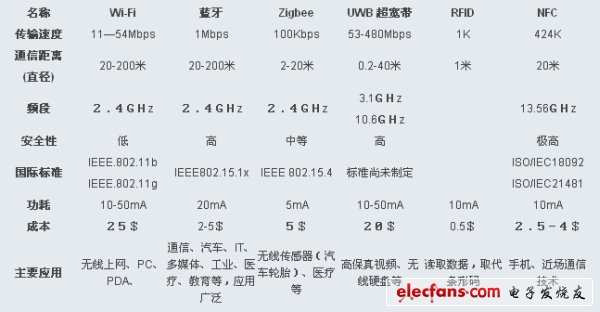With the continuous development of society, the advantages of wireless have gradually emerged. For example, the coverage of wireless communication is large, and it is almost unrestricted by geographical environment; wireless communication can be set up at any time, and links can be added at any time, and installation and expansion are convenient; wireless communication can quickly establish communication links within tens of minutes to achieve temporary, The purpose of emergency and disaster-resistant communication; while wired communication has geographical limitations and long response time. Wireless communication is beyond the traditional wired communication methods in terms of reliability, availability and invulnerability, especially in some special geographical environments. With the maturity of wireless technology, industries such as industry and medical care are beginning to use 2.4G communication more and more, and 802.15.4, ZigBee and Wi-Fi are also getting more applications. ZigBee and Wi-Fi each have obvious characteristics, and many features are complementary. Combining the two has a good application prospect. In order to help engineers and friends to answer more questions about design and application, this expert invited Mr. Liu Wei, technical director of Beijing Boxun Technology Co., Ltd. to share his experience in design.
What is the difference between ZigBee and Wi-Fi?
A comparison of ZigBee, Wi-Fi, Bluetooth and several wireless technologies is shown in the following table:

Comparison of ZigBee, Wi-Fi, Bluetooth and several wireless technologies
ZigBee, Wi-Fi, Bluetooth and several wireless technologies
Wi-Fi is currently in volume use, primarily in the home and office environment for local area networks such as PCs. After 3G deployment, there will be some applications of 3G+Wi-Fi, and China Telecom’s “Tianyi†will include this part. It is foreseeable that many embedded Wi-Fi devices will also become more popular with the convenience of the network, such as Wi-Fi POS machines and Wi-Fi scales in supermarkets. Nowadays, there are many applications in the industrial environment, mainly in the Wi-Fi access of serial devices, for industrial wireless data acquisition systems.
ZigBee and IEEE802.15.4 devices are mainly focused on: wireless sensor detection, low-level control in the industry; personal monitoring instruments, low-power wireless medical equipment; high-end toys; electrical networking and control; wireless consumer equipment; HVAC and lighting control Wait. Current batch applications are mainly in asset tracking, logistics management, intelligent lighting, remote control, medical care and remote meter reading systems.
How does 2.4G wireless technology solve the problem of band crowding?
802.15.4 uses DSSS and 802.11 uses DSSS and OFDM. In actual use, we have tested the environment of office buildings, factories and so on. Communication is more subject to blocking and distance problems, and congestion does not have much impact.
802.15.4, Zigbee technology is the most ideal choice for WSN networks, with low power consumption characteristics, but how to achieve low power consumption, what factors need to be considered?
IEEE 802.15.4 defines an optional MAC layer superframe structure. The superframe consists of two parts: active (AcTIve) and inactive (InacTIve). In the inactive part, the device can enter the low power mode (sleep state); The active part is divided into a competition period and a non-competition period. The competition period is provided to devices that are connected by CSMA-CA. The non-competition period consists of several guaranteed time slots and is provided to some devices that need to reserve a certain data bandwidth. The superframe structure embodies a feature of IEEE 802.15.4 low power consumption. The introduction of the inactive period limits the turn-on time of the transceivers between devices, and makes them sleep during no data transmission, thus greatly saving power. expenditure.
Zigbee devices are divided into full-featured devices and reduced-function devices. The reduced-function devices are simpler than the full-featured device stacks and have smaller memory. They can only interact with a full-featured device. Full-featured devices have complete IEEE 802.15.4 protocol functions. It can interact with any node in its transmission range. The two devices can be combined to form a mesh network, a star network and a tree network.
Low-power systems have power relationships in the CPU and other parts of the system, in addition to power consumption considerations in transmission. For example, the JN5139 SoC itself can turn off the RF and run the CPU part separately. It is also possible to turn off the SoC's on-chip ADC, serial port and other peripherals. For sleep, it is also possible to provide sleep for fast start-up of RAM content, sleep with interrupt/comparator/TImer wake-up and deep sleep with Reset only wake-up. In this way, the entire system can reasonably achieve a balance between function and power consumption.
What is the bandwidth of the Zigbee signal?
The underlying layer of ZigBee uses IEEE802.15.4, which means that the physical bandwidth is the bandwidth of IEEE802.15.4, that is, 250kbps. However, there is a difference between physical bandwidth and effective data rate. For ZigBee, the data rate also considers the topology of the network, the data routing relationship, and the amount of data in the network. These factors must be fully considered in the actual application. Since there are many factors involved, the actual calculation cannot be given here. As a rule of thumb, routing has the greatest impact on data rates. Each additional level of routing adds 100ms to 200ms. So ZigBee is not a real-time network. Secondly, the network concurrent data also has a large impact on the rate. In short, ZigBee is suitable for low-speed sensing applications, and the actual bandwidth should be considered in the actual situation of the network.
Double Burner Electric Hotplate
Double Iron Hotplate,Double Burner Electric Hotplate,220V Hotplate,Double Burner Hot Plate
Shaoxing Haoda Electrical Appliance Co.,Ltd , https://www.hotplates.nl
![<?echo $_SERVER['SERVER_NAME'];?>](/template/twentyseventeen/skin/images/header.jpg)